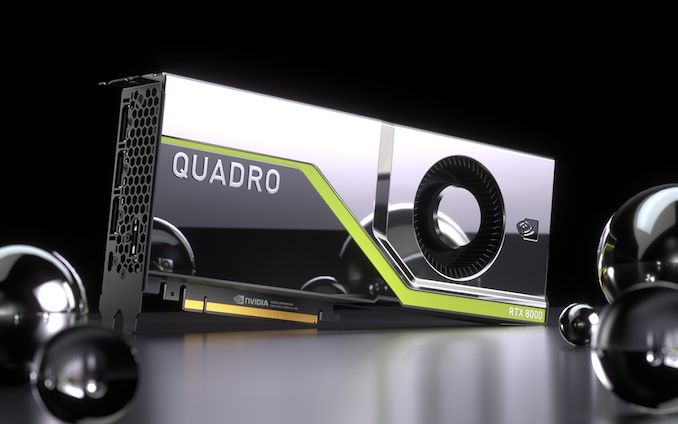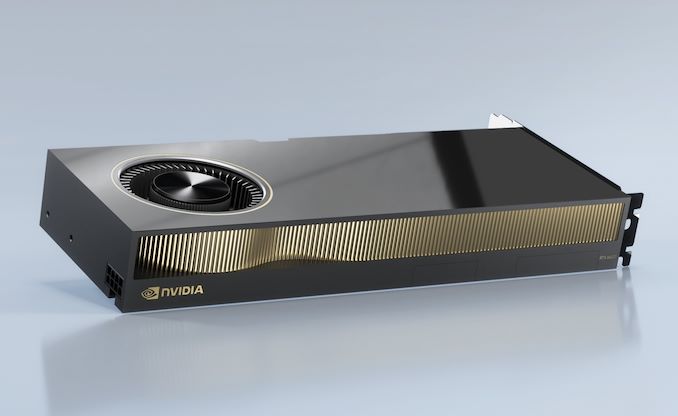More On NVIDIA Quadro Brand Retirement: Embracing the Graphics and Compute Overlap
by Ryan Smith on October 13, 2020 5:45 PM EST- Posted in
- GPUs
- Quadro
- NVIDIA
- Quadro RTX
- Ampere

Now that NVIDIA’s second GTC event of the year has wrapped up, we’ve finally gotten a chance to follow up with NVIDIA on last week’s announcement of their RTX A6000 video card, and what that means for the Quadro brand. In short, NVIDIA has confirmed that the Quadro brand is going away for sure, and as we suspected, it’s largely due to the overlap between graphics and compute.
As a quick refresher, last week NVIDIA launched their new professional visualization-focused video card, the RTX A6000. Based on the new GA102 GPU, the card ticks all the boxes for a high-end, pro-grade video card; and under normal circumstances, it would be part of NVIDIA’s Quadro family of products. However the card was notably excluded from the Quadro family in something of a last-minute change. At the time it wasn’t clear just what this meant for the Quadro brand as a whole, but now that GTC has wrapped we’ve been given some better insights into what’s going on.
First and foremost, NVIDIA has confirmed that the Quadro brand is being retired, or “streamlined” as the company calls it. Similar to the Tesla brand a couple of years back, the brand is set to be slowly retired from the market, as new professional visualization cards are released without the Quadro branding. Going forward, all of these cards will be given brand-less names, such as the “NVIDIA RTX A6000” and “NVIDIA A40”.
The more interesting aspect to this change is why: why would NVIDIA retire one of its oldest video card brands after so long? After all, the market for pro cards isn’t going away, and it remains a tidy, profitable business for NVIDIA. At the time we suspected that this has to do with the increasing overlap in NVIDIA’s product lines between professional visualization cards and compute cards, and the company has since confirmed that our hunch was correct.
As NVIDIA has continued to expand into the compute market, their professional visualization (ProViz) and compute products have increasingly overlapped in terms of features and pricing. As NVIDIA already charges “full” price for both their compute and ProViz cards, there are little-if-any feature differences between the two: desktop ProViz cards have the same access to compute features as compute cards. And compute cards, though almost exclusively server-mounted, can be provisioned as a virtual ProViz card as well.
One of the consequences of which has been that NVIDIA’s own messaging on what cards can do what tasks has become unfocused, never mind potentially confusing customers. If you need an actively-cooled desktop card for running neural network prototyping, for example, what card do you buy? Previously it was the Quadro card, despite the fact that it was a ProViz part. Similarly, the ex-Tesla V100 makes a great part for provisioning a virtual Quadro instance, even though it’s not a Quadro part.
As a result, NVIDIA has opted to go the route of essentially merging their compute and ProViz hardware lineups in an effort to simplify their offerings. NVIDIA wants for there to be a single brand – NVIDIA – which covers both markets, reflecting the flexibility of their cards and (largely) eliminating questions over which cards can be used for graphics or compute. At the same time, this also allows NVIDIA to reduce the number of hardware SKUs offered, as they no longer need overlapping products at the fringes of these markets.
Ultimately, the market for ProViz and for computing has quickly become one and the same. Though the two differ in their specific needs, they still use the same NVIDIA hardware and pay the same NVIDIA “premium”. So both are set to become a single product line to cover the needs of all of NVIDIA’s professional and commercial customers, whatever their graphics and compute needs.











34 Comments
View All Comments
CiccioB - Wednesday, October 14, 2020 - link
How is removing a brand from a name but keeping it targeted to the same market makes the product cheaper?AMD has nothing in this market that can compete. RDNA2 lacks most of Nvidia advanced features (Tensor for instance) and cannot be used for a bunch of works these cards are meant for (IA, DeepLearning and 3D rendering where tensor helps with filtering).
Spunjji - Wednesday, October 14, 2020 - link
Bold statement to make when we don't actually know any of this :|CiccioB - Wednesday, October 14, 2020 - link
It's a fanboy hope for a "wait and see" suggestion when RDNA2 won't have any tensor acceleration for sure (the die is already big the way it is now with hybrid faked RT accelerators).You may be speaking about CDNA, but that is N/A for now.
Smell This - Wednesday, October 14, 2020 - link
Your pants are on fire in so many different ways . . .AMD Radeon Pro Graphics Supported on AMD Radeon Software
https://www.amd.com/en/technologies/radeon-pro-sof...
CiccioB - Thursday, October 15, 2020 - link
What is that link related to what I have stated?Smell This - Monday, October 19, 2020 - link
high performance computing on graphics processing units: hgpu.orghttps://hgpu.org/?s=amd+gemm
Machine learning using GEMM, 3D, etc., with AMD Radeon Pro Graphics and AMD RDNA Architecture, Vega, GCN even APUs & mobile
CDNA is CPU/GPU on what appears to be Eypc, a fabric arch and unified memory(?) ___ does not mean that the above will not to continue work just dandy in the pro environment INCLUDING RDNA2 (► What Spunjji said)
We will find out in 9 days or so ___ and I am feeling a sense of desperation from the other green team.
evilspoons - Wednesday, October 14, 2020 - link
The expression is "one and the same", not "one in the same".Jbon - Wednesday, October 14, 2020 - link
Stating that compute cards can be provisioned for proviz isn't exactly truthful. For example the A100 doesn't even have NVENC and thus would be terrible for VDI.frenchy_2001 - Wednesday, October 14, 2020 - link
But that wasn't what the article said. They said some of those functions are overlapping.Obviously, an A100, which has literally no display port would be a hard sell for local visualization.
The point is that the functions performed by those products are increasingly overlapping, hence the end of the distinct brand names (quadro and tesla). Each model will still have a set of capabilities that will make it fit or unfit for your purpose.
Carl Bicknell - Wednesday, October 14, 2020 - link
Seems to me the user now has to assess the new cards on their own merit and decide which one is best, rather than sticking to a known brand name. For some people that's going to make it harder.